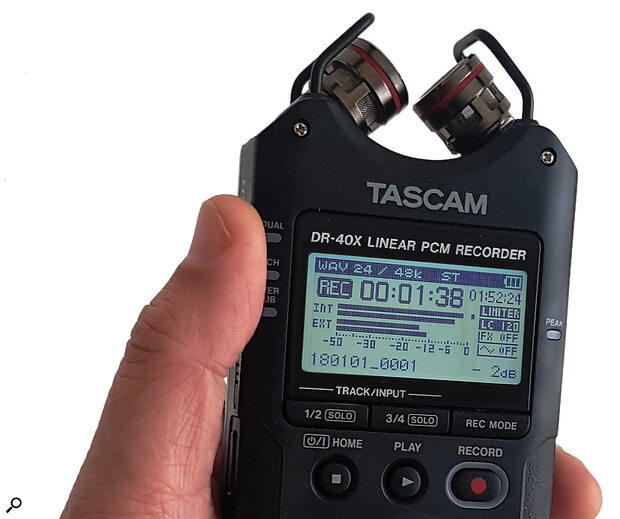 The cardioid capsules of stereo recorders and affordable stereo mics are often configured as a coincident X‑Y array. At practical distances when recording ensembles, though, the recording angle tends to result in a narrow image. But increasingly, as with this Tascam DR‑40X, you’re able to change the angle.
The cardioid capsules of stereo recorders and affordable stereo mics are often configured as a coincident X‑Y array. At practical distances when recording ensembles, though, the recording angle tends to result in a narrow image. But increasingly, as with this Tascam DR‑40X, you’re able to change the angle.
I recorded, with a Shure stereo mic, two musicians placed about two feet apart, but although the stereo recording I obtained is solid and focused, it doesn’t have a very wide stereo image. (I will try a stereo widener and/or some reverb, in case that helps.) I also used two additional Line Audio CM3 cardioid mics, located about six feet apart and pointed slightly inwards. If I pan these off‑centre in opposite directions, the sound becomes very nice and spacious indeed on headphones, but the phase meter starts dipping way into the red, and the imaging is somewhat vague in comparison. If I back off on the panning extremes the sound is still nice where the phase meter doesn’t cross the line past the centre zero.
What I’m wrestling with here is whether the finished recording should be a document of what it was (via the stereo mic with the narrow stereo image), or the enhanced larger experience with the spaced mics. I feel like I am drifting into mixing philosophy but I’m leaning towards ‘go big or go home’. What would you advise?
SOS Forum post
SOS Technical Editor Hugh Robjohns replies: You’re not giving us much to work with here, but I’m going to assume your “stereo mic” recording was made with a coincident (X‑Y) cardioid combination of some sort. That kind of array has an enormous stereo recording angle (SRA), approaching 180 degrees, and that would mean that unless the mic is placed extremely close to the ensemble, the musicians would only occupy a small proportion of the full SRA — and, subsequently, the musicians will inherently span a fairly narrow stereo image, with the room sound filling out the rest to the sides.
The coincident cardioid X‑Y array is very common on handheld stereo recorders and in fixed‑capsule stereo mics, but it’s rarely a good choice for recording ensembles, because at any kind of distance the imaging gets very narrow.
Conventional stereo‑width enhancers work very well on coincident arrays like this, without introducing nasty phase problems.
Conventional stereo‑width enhancers work very well on coincident arrays like this, without introducing nasty phase problems (unless you really take it to extremes), so you could certainly broaden your imaging that way very effectively if you wished. And if the recording lacks a nice room acoustic, everyone loves a bit of spacious reverb — that will keep your ensemble sounding intimate while placing them within a nice acoustic space.
I don’t know what your plan was for the two spaced microphones, but if they’re panned hard left/right then this arrangement is likely to result in two ‘puddles’ of sound and a big hole between them in the middle. This is essentially what the phase meter was warning you about. If the mics are panned mid‑way towards the left/right there might potentially be quite a lot of coloration or phasiness (think comb‑filtering) due to the time offset of acoustic crosstalk between the source instruments and mics.
At the end of the day, though, the question is, as you’ve said, how you want it to sound. There’s no rule to say the result has to be true to what you heard in the room: you’re creating a form of art here, so the mix can be whatever you want it to be. That said, you probably still want it to give the impression of sounding somewhat ‘natural’. Personally, when there are only two performers contributing, I don’t usually like them to be panned very wide, such that they come predominantly from individual speaker cabinets or earphones; that always sounds too artificial and distracting to me. Some modest separation between the performers is nice, though. I typically aim for 4‑6 dB offsets left and right of centre. The rest of the soundstage would ideally be filled with the recorded room acoustic if there is one, or with artificial reverb to give a sense of space.
